
A comprehensive introduction to sound healing
The use of sound and vibration to enhance one's physical, mental, and emotional well-being is known as sound healing. It has been employed throughout history as a technique of healing, unwinding, and spiritual development by various civilisations. A growing number of individuals are turning to alternative and holistic methods of health and healing, and sound healing has become more and more popular in the current wellness sector. This article provides a thorough introduction to sound healing by examining its origins, guiding concepts, and different therapeutic approaches.
The Evolution of Sound Therapy
Sound has been used as a therapeutic tool for thousands of years. Ancient societies across the world, including the Egyptians, Greeks, and indigenous peoples, were all aware of the tremendous effects that music might have on the body and mind. For the purpose of reestablishing harmony and balance in both people and communities, they employed chanting, drums, singing bowls, and other musical instruments.
In Eastern cultures, the chakra system—an energy system said to control the body's essential processes—has long been connected to music. It was thought that activities like mantra chanting, employing particular musical scales, and playing particular instruments would balance and activate the chakras, enhancing health and well-being.
The Foundations of Sonic Healing
The fundamental tenet of sound healing is that everything in the cosmos is composed of energy and vibration. Our body's many cells, organs, and systems each have a distinct vibrational frequency. These frequencies are in balance when we are in good health. These frequencies can be disturbed by sickness, stress, and bad emotions, which can result in imbalance and disease.
By infusing healing sounds and vibrations into the body, sound healing tries to bring harmony back. These vibrations interact with the body's own energy field to encourage calmness, relieve stress, and aid the body's own healing mechanisms. In order to maximise the benefits of other holistic techniques like meditation, breathwork, and energy healing, sound healing is frequently practised alongside them.
Various Sound Healing Techniques
There are many different types of sound healing, each with its own special techniques and equipment. Here are a few of the most widely practised sound healing modalities:
Vocal Toning: Vocal toning is the practise of producing prolonged vowel sounds or certain frequencies using the voice. It can facilitate the discharge of emotional blockages, energy centre balancing, and the development of inner peace.
Metal or crystal bowls called singing bowls make deep, resonant tones when hammered or played with a mallet. The bowls' vibrations have the power to encourage meditation, profound relaxation, and stress reduction.
Tuning forks: Tuning forks are precise instruments that, when hit, create particular frequencies. They are frequently used to restore equilibrium to the body's energy centres, boost circulation, and relieve stress and discomfort.
Gong Baths: In a gong bath, you immerse yourself in the sound vibrations that the instruments make. Deep meditation can be made easier by the gong's soothing tones, which can also help people feel calmer and let go of emotional tension.
Binaural Beats: When two frequencies are played simultaneously in each ear, the brain registers a third frequency. This phenomenon is said to increase meditation, attention, and relaxation.
Considerations and Benefits
Numerous advantages have been linked to sound healing, including stress reduction, better sleep, increased attention, pain alleviation, and emotional release. It can encourage self-reflection and inner investigation, which can promote general well-being and spiritual development.
While typically safe and non-invasive, sound healing may not be appropriate for everyone. Before using sound healing techniques, anyone with certain medical issues or sound sensitivity should speak with a healthcare provider. Working with a qualified sound healing practitioner who can adapt the experience to your unique requirements and lead you through the procedure is also crucial.
In conclusion, sound healing is a potent and age-old practise that makes use of sound's and vibration's therapeutic properties to encourage healing and well-being. Its lengthy history, which is steeped in many different civilisations, underlines its constant importance over time. People may set out on a path of self-discovery and transformation by learning the fundamentals of sound healing and investigating the many techniques. The therapeutic power of sound can be accessed through voice toning, singing bowls, tuning forks, gong baths, or binaural beats in order to reestablish balance, lessen stress, and improve general well-being. As sound therapy gains popularity and acceptance, it provides a comprehensive therapeutic method that supports and broadens our concept of well-being in the contemporary environment.
Uncover the benefits and considerations of sound healing and embark on a path of self-discovery and transformation. Experience the therapeutic power of sound and start your sound healing journey today!



